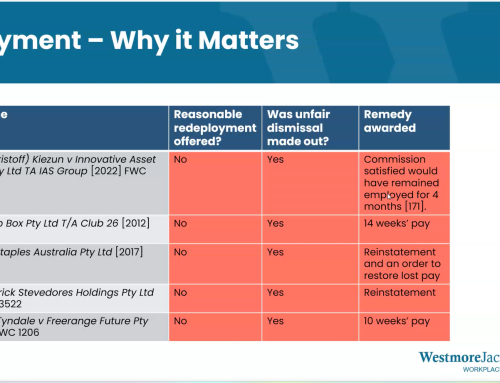
The cases do not give a clear answer. However, they do suggest the business rationale for using contractors or labour hire is very important to defending an unfair dismissal claim on account of genuine redundancy.
We explore this issue below.
The basics
Let’s start with the basics.
First, a redundancy will not be ‘genuine’ under the Fair Work Act if it would have been reasonable in all the circumstances to redeploy the employee. The cases suggest employers who don’t comply with this are likely to be ordered to pay compensation towards the higher end of the 0 to 6 months scale. So it’s important to get redeployment right.
Second, the cases also say that redeployment should be to a job or a position or other work to which it is reasonable in all the circumstances to redeploy the redundant employee. This raises two issues:
- Does this mean ‘other work’ a contractor or labour hire worker is doing capable of being a redeployment opportunity?
- Would it be reasonable to take this ‘other work’ away from the labour hire worker or contractor and then give it to a redundant employee?
There are no hard and fast answers here. But the cases do provide some guidance.
When it’s reasonable to not terminate contractors and labour hire workers
The cases suggest employers need not create jobs for redundant employees by terminating contractors and labour hire where:
- Legitimate business strategy to cover absenteeism: The use of such contractors and/or labour hire is part of a legitimate strategy to cover absenteeism amongst the employer’s permanent workforce;
- It is not practicable to terminate contractors or labour hire workers: This may be because, for example, the employer has and is reducing its use of contractors and labour hire workers who only perform sporadic work, which may not exist in the future;
- No certainty regarding future work: There is no certainty whether the work performed by labour hire workers or contractors will exist in the future;
- Specialised skills: Contractors and labour hire workers are performing specialised work which employees cannot perform, even after a reasonable period retraining.
In my view, the Commission may also consider it reasonable to not terminate a contractor or labour hire worker as to free up work for a redundant employee if the contractor or the labour hire company is contractually obliged to give something of commercial value to the employer. This would need to be something a redundant employee cannot (or is unlikely to) provide the employer. Examples which come to mind include contractors or labour hire companies promising:
- Indemnities for, amongst other things, negligent or incomplete work;
- Reduced fees for the contractor or labour hire company if KPIs are not met;
- Guarantees that certain work will be performed within a specified time and/or to a specified quality;
- The right to terminate the engagement without notice.
If contractors or labour hire provide something that a redundant employee cannot, then this may be a persuasive business rationale for not freeing up ‘other work’ for redundant employees by terminating contractors or labour hire workers.
Adam Colquhoun, Principal






Leave A Comment